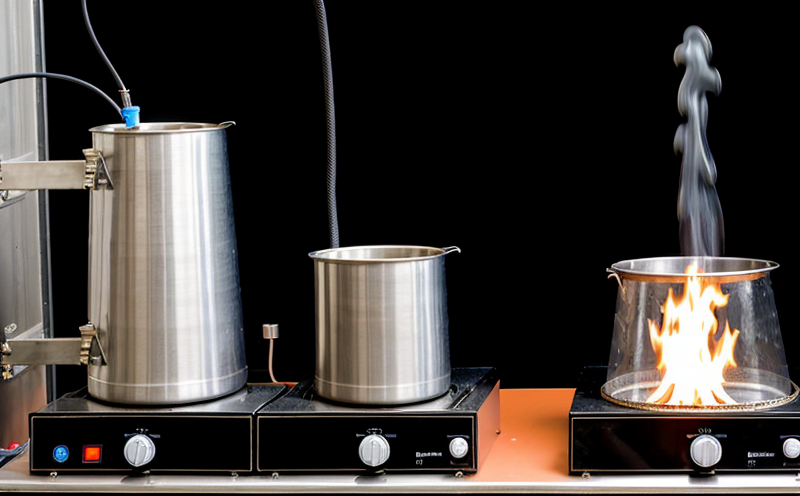Heat Release Rate at 100 kW/m² Incident Heat Flux
The heat release rate (HRR) test at 100 kW/m² incident heat flux is a critical aspect of fire safety testing. This method evaluates the flammability and heat release characteristics of materials under intense heat conditions, which are crucial for understanding their performance in real-world scenarios such as fires in buildings or vehicles.
During this test, a specimen is exposed to an incident heat flux of 100 kW/m², and its heat release rate is measured. This intensity simulates the conditions of rapid combustion, allowing us to assess how quickly a material can release heat energy under extreme temperatures. The HRR value provides valuable information about the material's potential for generating smoke and toxic gases during a fire.
The test setup typically involves placing a specimen in a calorimeter equipped with sensors to monitor temperature, oxygen concentration, and other parameters. The incident heat flux is generated by an external heat source that simulates the conditions of a real fire. This method ensures precise measurement of the material's response under controlled laboratory conditions.
Understanding the HRR at 100 kW/m² is essential for several reasons:
- Regulatory Compliance: Many international standards, such as ISO 5636-2 and ASTM E968, require this test to ensure materials meet fire safety regulations.
- Risk Assessment: This test helps in assessing the potential risk associated with using a particular material in high-risk environments like aircraft interiors or hospital facilities.
- Material Selection: By evaluating HRR at 100 kW/m², engineers can make informed decisions about which materials to use for specific applications based on their fire resistance and safety performance.
The test results are used to derive important parameters such as the onset time of ignition, the heat release rate curve, and the peak heat release rate. These metrics provide a comprehensive understanding of the material's behavior under extreme conditions, which is vital for ensuring product safety and compliance with fire safety codes.
In summary, the HRR at 100 kW/m² incident heat flux test is a fundamental tool in fire safety testing that helps ensure materials perform reliably and safely under intense thermal stress. This service plays a crucial role in enhancing the fire resistance of products across various sectors including aerospace, automotive, and construction.
Industry Applications
- Aerospace: Evaluating materials for use in aircraft interiors to ensure they meet stringent fire safety standards.
- Automotive: Assessing the flame retardancy of seat covers, upholstery, and other interior components used in vehicles.
- Construction: Testing building materials like insulation panels and wallboard to determine their fire resistance properties.
- Textile Industry: Determining the flammability characteristics of fabrics intended for use in safety-critical applications.
The HRR at 100 kW/m² incident heat flux is particularly important in these industries as it helps ensure that materials used are safe and comply with relevant fire safety regulations. This test allows manufacturers to make informed decisions about material selection, ensuring the products they produce meet strict safety standards.
Quality and Reliability Assurance
Ensuring that materials perform consistently under fire conditions is essential for quality assurance in any industry. The HRR at 100 kW/m² incident heat flux test plays a vital role in this process by providing reliable data on material performance. This data is used to identify any inconsistencies or areas where improvements are needed, ensuring the highest level of product reliability.
The testing process itself must adhere to strict standards and protocols to ensure accurate results. For instance, the calorimeter used for these tests must be calibrated regularly to maintain precision. The specimen preparation procedures also need to follow specific guidelines to ensure that any variations in test outcomes are due to material properties rather than procedural errors.
The data generated from this test is crucial for quality assurance teams. It helps them identify trends and patterns that could indicate issues with the manufacturing process or material sourcing. By using consistent testing methods, manufacturers can build a robust quality management system that ensures their products meet the highest safety standards.
Use Cases and Application Examples
The HRR at 100 kW/m² incident heat flux test is widely used in various industries to ensure product safety. Here are some specific use cases:
- Aerospace: Testing the flammability of seat covers, upholstery, and other interior materials for aircraft interiors.
- Automotive: Evaluating the flame retardancy of fabrics used in seat covers and other interior components.
- Construction: Assessing the fire resistance properties of insulation panels and wallboard used in buildings.
- Textile Industry: Determining the flammability characteristics of fabrics intended for use in safety-critical applications.
In each case, the test results are essential for compliance with international standards such as ISO 5636-2 and ASTM E968. These standards provide specific criteria that materials must meet to ensure they can withstand fire conditions without releasing excessive amounts of heat or toxic gases.
The HRR at 100 kW/m² incident heat flux test is also used in research and development to innovate safer products. By understanding how different materials perform under intense heat, manufacturers can develop new materials with improved fire resistance properties.





